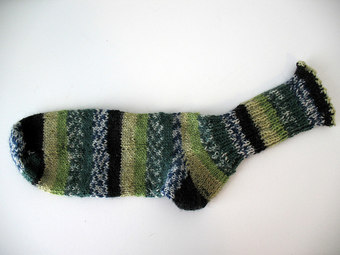|
The hole in the bottom of the sock tells a person many things. The first of which is the obvious one that you need a new pair of socks. But it also says you and that sock have traveled many miles together and have done many things that you couldn’t have done without that sock. That sock cushioned your heel and protected your ankles from the rough embrace of those new hiking boots you bought. So after traveling so many miles together and now full of holes what can this humble sock do for you now. Most people take this sock and simply discard it in favor of one not so full of holes. I think that is a waste of a wonderful piece of fabric that has lots of life left in it when you look at it in a whole new light.
To that end I am going to tell you about a few different ways you can put a old worn out sock to use around the house. 
Staining Rags
For those of you out there that do a lot of woodworking you are most likely familiar with the various properties of wood stains and varnishes. One of the more annoying properties is that unless you clean out your brushes really well after each use you can ruin brushes quickly. A way around this is to use the old worn out socks as staining rags. They tend to be abundant around the house and the shape and materials found in socks make for very effective staining rags. I personally like to hold on the top of the sock and just dip the toe portion into the stain. If done correctly you can get a rag that drips very little and is easy to use on wood. Then when it is time to apply some sort of varnish you can simply use the other side of the sock that is still clean and use it to apply the finishing layer. Dusting and Waxing One of the major cleaning chores that occurs in my house is dusting. We have a lot of dust and dander from our heating system and pets that is constantly getting deposited everywhere. A nice standard sock works pretty good as a dry dust rag. All the little fibers in the socks are great at picking up dust and hair and the best part is you can just wear it on your hand. It make look like you are trying to put on a sock puppet show but it is an effective way to dust. LIke other dusting rags you can just wash and reuse which is great since you would hate to throw away something so useful. I also have found socks a great way to apply wax to furniture, bow staves and other wood products that need some wax based TLC. Again you can just wear the sock on your hand and it’s really easy to work the wax on the surface of whatever you are applying. It works really wells at applying boot waxes and greases as well, you can just keep the same sock with your grease and just use it again and again till it gets really dirty. Pet Toys Pretty much any sort of fabric can be turned into some sort of toy for the pets. The easiest way to turn socks into a toy is to tie two together and then tie additional knots in the socks as needed to make it a good rope toy. That will typically only work with the longer tube socks if you wear ankle socks or have lots of kid socks then a cat toys on a stick and string with probably be the way to go. The socks make for a safe and effective toy for the pets since they are typically made mostly or completely of natural fibers like cotton or wool. Reusable Heat Pads This one is a little more off the wall but it really does work. To make a heat pad out of a sock is a easy thing to do. All you need is a old tube sock that doesn’t actually have holes in it and some plain uncooked rice. You will then fill the sock about ¾ full of rice and tie the end closed so the rice can’t fall out. To heat it up all you have to do is throw it in the microwave for a minute or two and you have a instantly hot and moldable heat pad. This is great for those shoulder aches and for wrapping around sore joints. It you get a long enough sock you can make a one that can stretch completely across your back or along your spine.
0 Comments
Leave a Reply. |
AuthorHello my name is Josh Larson and I am the creator of the Green Living Library. Here on the blog you will find updates to content found in the Green Living Library as well as stories from those living the sustainable life already. Archives
December 2021
Categories
All
|